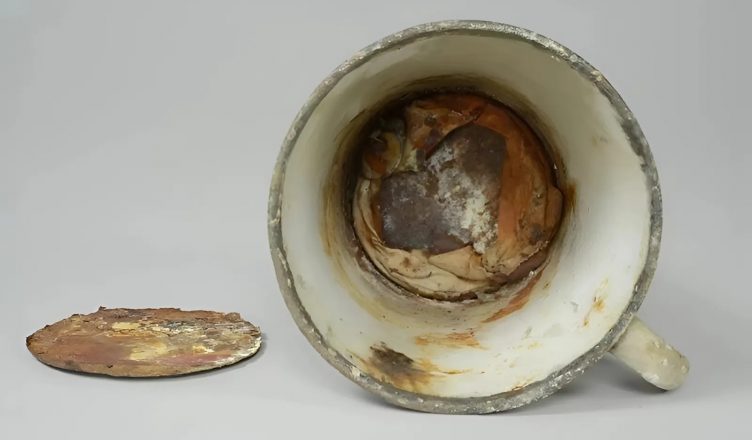For seventy years, it stood silently behind glass. A plain ceramic cup, one of thousands displayed at the Auschwitz-Birkenau State Museum — a remnant of the Holocaust, a fragment of the everyday lives lost to one of history’s darkest chapters. Nothing about it stood out. No engravings. No markings. Just a common object amid countless others that once belonged to people stripped of everything.
But recently, this seemingly unremarkable cup revealed a secret — one that had remained hidden for decades. As the bottom of the cup began to deteriorate due to age, museum conservators discovered something astonishing: a hidden compartment beneath the base. Inside it, wrapped in a nearly disintegrated piece of cloth, were a small gold ring and a pair of earrings — a concealed treasure, rich in symbolism, that had survived both the Holocaust and time itself.
A Discovery Born of Decay
The discovery came during a routine conservation inspection. Museum staff noted signs of structural weakness in the cup’s base. Concerned about potential collapse, they transferred the item to the restoration lab. While carefully examining and stabilizing the fragile ceramic, conservators removed a crumbling inner layer — and what they found beneath astonished them.
Hidden inside was a secret compartment, purposefully carved or molded into the bottom. Nestled within it was a small bundle containing jewelry: a ring and two earrings. The cloth that had wrapped them was nearly gone, eaten away by time and moisture, but the jewelry remained intact.
These were not just trinkets. They were acts of resistance, symbols of identity, dignity, and hope.
Why Hide Jewelry in a Cup?
When Jewish families and other persecuted groups were deported to Nazi concentration camps, they were often told to bring basic belongings for “resettlement.” In reality, all their possessions were seized upon arrival. The Nazis confiscated everything — from suitcases to watches, from coins to wedding rings.

But many deportees attempted to hide their most precious items, believing they might one day reclaim them — or trade them to survive. Some sewed valuables into clothing. Others stashed them inside bread, under soles of shoes, or — as this case reveals — inside a simple drinking cup.
Why a cup? It was ordinary, unlikely to be searched too closely, and possibly considered an item essential enough to keep. For the woman — for it is likely that the cup’s owner was female — this hiding place represented one last grasp at ownership, autonomy, and memory.
The Symbolic Power of the Find
This discovery is not about monetary value. It’s about emotional weight and historical importance. That cup, silent for decades, now speaks with a powerful voice. The woman who hid those items may never be identified, but her presence is now palpable. Her hands once held this object. Her fear and courage are embedded in its ceramic frame.
It is a haunting reminder: behind every item in the Auschwitz museum — every shoe, every comb, every suitcase — was a person with a name, a story, and a life. A person who hoped, resisted, and tried to hold onto something in the face of absolute dehumanization.
Global Reaction and Reflections
News of the discovery spread rapidly. International media outlets picked up the story. On social media, reactions poured in — from Holocaust survivors and descendants, to teachers, historians, and everyday readers. Many expressed deep emotion, describing the find as “heartbreaking,” “powerful,” and “deeply human.”
“This woman speaks through this cup,” wrote one user. “Even in death, even after seventy years, she reaches out and reminds us: I was here. I mattered.”
What Happens Next?
The Auschwitz Museum has confirmed that the cup and its contents will undergo detailed preservation and study. Experts are analyzing the materials — the type of ceramic, the gold, even the cloth — in hopes of learning more about their origins.
It’s unlikely the identity of the owner will be discovered. Records were lost. Identities erased. But this does not diminish the significance. The museum plans to feature the cup and jewelry in a dedicated exhibition, along with other objects that speak to the private, personal lives of those who perished.
Additionally, educators and curators see this as an opportunity to enhance Holocaust education — to move beyond statistics and emphasize individual stories. Because history, after all, is not about numbers. It is about people.
